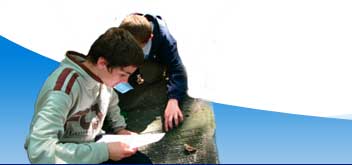"To Bring Memory Back" edition 2006-2007
ŁĘCZNA- Zespół Szkół Nr 1, I Liceum Ogólnokształcące im. Jana Zamoyskiego

Who are we
Jan Zamoyski High School No.1
We realize our project under supervision of our Professor, Marzena Niedźwiadek, the creator of the circle of interest studying Jewish culture. Our circle is composed of 20 students from the classes I B and II B.
Why we do this project
We want to "bring back the memory" of old Łęczna, where Poles and Jews coexisted peacefully.Jewish community in our town
We collected information about the Jewish community of Łęczna. Here’s what we found out:
In the period between World War I and World War II more than a half of Łęczna’s inhabitants were Jews. They owned almost 90% of shops and many workshops. They had their own cultural, political and social organizations. The situation changed radically after the start of World War II. Confiscations, contributions and robberies dispossessed the Jewish people. They lost their livelihood. The German government intended to eliminate Jews from social and economical life, to use them as a cheap manpower, and then – to exterminate them totally. In 1940 the Jews of Łęczna were resettled to the outskirts. Dwellers of that part of the town had to receive those who lost all their belongings during the confiscation. Living conditions were very poor. Jewish people felt really unsafe because of chicanery, injunction on leaving the place of settlement, requisition of wearing the yellow star symbol and because of curfew. All over the occupied Europe Judenräte, the Jewish councils, were created to organize the Jewish communities’ life. In Łęczna, such council was created in November 1939. It consisted of 12 members. The oldest of them was 60 years old and the youngest was 23. Five of them were merchants; there were also tailors, a carpenter, a rope maker and a baker. Łęczna’s Jewish Council handled all the affairs involving Jews. The Council took care of locating Jews who had been resettled from the western Poland in years 1939/1940 (after they came, the number of Jews in Łęczna increased from 1400 to 2300 people). Jews from the work camp in Łęczna worked hard building roads. Following the invader’s orders, Judenrat had to supply some of the workers to the work camp in Bełżec. Judenrat nominated dr. Adolf Israel Flater to take care of the workers. He couldn’t do much, because he didn’t have enough medicines and bandages. To help the Jewish Council, Ordnungsdienst (Jewish police) was created. The police had to maintain order in ghettos, prevent crime and help in transporting Jews to the camps. Members of the Jewish police were an instrument in SS and Gestapo’s hands. Some of them hoped to save their lives working for the enemy. In Łęczna, there was also an Ordnungsdienst department. It was leaded by Shmul Puterman and the members were: Yosef Hokhzynger, Aron Feyn, Berek Borshteyn, Hersh Rabinovitch, Mayer David Altman, Anchel Epelbaum, Aron Reihshteyn, Leyzor Frydman, Finkelshteyn, Yakob Goldberg, Abram Blones, Shmul Vaynmus, Itzek David Hokhzynger, Moshek Shmul Veysmerder, Moshek Yosef Zylbershteyn, Symcha Bavnik, Leyzor Gertner, Hersh Borenshteyn and Volf Finkelshteyn. As time passed, living conditions of Jewish people became harder and harder. The Jewish Social Self-help came into being in General Government, leaded by a presidium placed in Cracow. In July 1940, a protective committee in Łęczna was created. Its leader was Itzek Zylbersteyn, the merchant. The committee’s members were: Mendel Tzukierman, Mordko Yosef Veinfeld, Berek Halpern und Hersh Frokhmann. The Jewish Protective Committee tried to aid charitable to help people who were quickly becoming poorer. The Committee organized a ‘kitchen of the people’ distributing meal for 200 people. The Committee managed also with distributing other kinds of social help, like financial grants and clothing, searched for lost persons, organized medical help. In May 1940, in Łęczna was created a Jewish sanitary service consisting of 2 paramedics and 6 other people. In Łęczna, such institutions like The Jewish Council, the Police, the Jewish Protective Committee and the Sanitary Service existed until 1942. It ceased existing in the moment of deportation of all remaining Jews to extermination camps.
What we do in the project
1. Take care of Jewish cemetery;
2. Recreate the cemetery's history;
3. Prepare a public inquiry concerning ethnic minorities;
4. Prepare a lesson about Jewish culture;
5. Organize a histoiry and literary contest "Memory of Jewish history and culture";
6. A trip to Lublin to visit a Holocaust location (Majdanek);
7. Prepare for a next edition of "History and culture of Polis Jews" contest, prepared by the Shalom Foundation;
We gathered informations about history of Jewish cemetery in cooperation with Regional Museum in Łęczna. We made pictures of this location.
In Leczna’s area there was a Jewish cemetery. Today on the place one can see a cluster of trees above some sports buildings, on the right side next to entry to town from Lublin’s direction. Even after the war there were some standing matzevot left on the cemetery. In times when Nazis were murdering Jewish population of Leczna the cemetery was devastated because the users and caretakers were there just no more. The place slowly fell into decline, tombstones were stolen by the residents and neighbours, used to many purposes: as foundation for new houses, farm buildings, stairs, thresholds, curbs, sharpeners and pavements. In the beginning of the fifties on the south side of the cemetery there were built two huts and some store-rooms, without anyone minding the surrounding graveyard. After total devastation the terrain was ploughed and planted with trees. After that the borders of the cemetery were completely obliterated, rest of tombstones went missing, the traces of graves vanished. The existence of a Jewish cemetery in Leczna is the evidence of fully formed kahal or Jewish Community. No one knows when the cemetery was established, no one has ever found evidence which could date the beginning of its existence – the matter still causes conflicts among historians. However it is known, that in 1846 the cemetery in Leczna took on a shape of a rectangle. Near the north-east corner there were two enclosures: probably farm buildings. Not so far there are two other edifices, maybe caretaker’s house and a tool-shed. Closer to the middle of the north side there is marked another smallish building. Most probably it was an ohel – a structure built above a grave of someone important. Assuredly it was a tomb of a famous Leczna’s Chassidic Tzadik, Shlomo Jehuda Leib, called „The Leczna’s One (pol. “Leczner”)” From the relations of residents we know it was still standing in the fifties of the 20th century. Jewish Community in the half of the 19th century, when reparations of the synagogue, house of prayer and mikva were finished, decided to employ itself with the cemetery and enlarge its borders by buying vicine grounds. The semblance of the cemetery before the war is known from the stories of Leczna’s inhabitants. Jewish cemetery was called a “gyergyel” here and it was located amid fields in the area called “Pasternik”. It was surrounded from three sides by a brick wall, from the south side there was a makeshift fence. The gate and the wicket were in the middle of the eastern wall. The caretaker’s house and the tool-shed were nearby. There were no trees on the cemetery, with an exception of three-four pears. The tombs were assembled mainly on north- and south side, aligned in rows – alternately a row of male- and female burials. They were oriented to the east, facing Jerusalem. On the tombstones there were Hebrew inscriptions, often adorned with bass-reliefs rich of symbols. The matzevot were made mainly from sandstone brought from Szydlowiec. There were also tombstones made from concrete, granite field stones, some even from wood. On the north side there was one, maybe two ohels.
- On November 29th 2006 we visited District’s Museum in Leczna which is located in historic synagogue from the half of 17th century. Our guide was Mrs Lesniewska, particularly interested in history of Leczna’s Jews.
We’ve realized three directives of the programme:
1. We visited the exhibition „Gates of Time. Jewish Sacral and Ceremonial Buildings”
2. We brought up the matter of Jewish way of living in the area of Leczna.
3. We learned about the history of the Great Synagogue in Leczna.
4. We learned also about ceremonies and garments – this will help us prepare a play about Jewish culture.
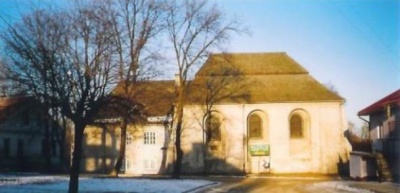
We’ve gathered the following information about the Synagogue in Leczna:
The synagogue was erected in about half of the 17th century, according to the agreement issued in 1648 by heiress Katarzyna Noskowska and a Krakow’s bishop, about which we can find out in Leczna’s town records inventory. Leczna’s Jews gained a permission „to build themselves a synagogue – bricked and 16 cubits high”. The town book where the document originally was has vanished and only this record in the inventory is the only trace telling us about accomplishing supposedly long-term endeavors of the locals. The synagogue can be counted as one of the sparsely preserved historical Jewish buildings in Lublin’s district. Originally it was a renaissance temple, supposedly crowned with an attic, with steeped roof. It was oriented, facing east and the Holy Land. After rebuilding it was baroque, with preserved renaissance interior. It was made from limestone and plastered. It was built on rectangular plan. The exterior elevation on south- and north side is three-axial, whereas eastern one has two axis with deep arcade niches, in which high windows with semi-circular endings are located. After the war to the western wall a two-storey building was built on where were located kahal’s offices and women empora, on the place of disassembled vestibule and women section. The roof is a steeped Polish one, covered with shingles.
In the interior of a Great Synagogue on the eastern wall there is Aron ha Kodesh (closet for the Scrolls) – bricked with two columns, decorated with stucco from the half of the 17th century.
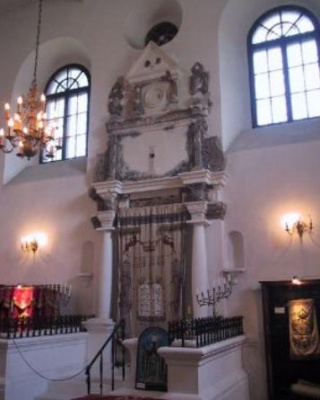
In central part there is a bricked bima – below it Torah was read and lectured, it was used also as a rostrum and a place for cantor to pray. It was built on a square plan with four Tuscan columns.
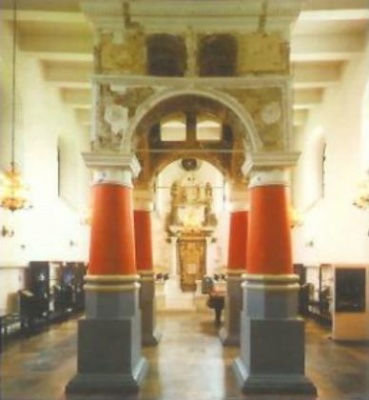
The Synagogue was burnt down in 1846 and 1881. Next it was rebuilt. In 1939-1944 Germans organized there a wheat warehouse, beginning the devastation of the building. After the liberation the people have done the rest – with tearing down the flooring and breaking all the woodwork. The demolition of the building and buttresses were done systematically, what threatened the wall would eventually collapse. The building of a kahal was demolished with only ground floor left. After II World War it was destroyed but yet again rebuilt in 1953-1964. After-the-war devastation was most disadvantageous – it had lead to devaluation of both the décor and the market’s worth. The synagogue is now a museum, gathering i.a. Jewish remembrances.
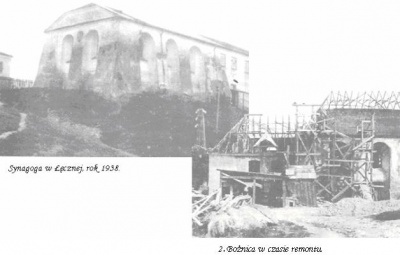 The Synagogue before...
The Synagogue before...
Betmidrash- a house of education, it was called also a house of prayer, Jewish school, Prayer School – a Little Synagogue. It was a synagogue and a school altogether where beside services three years old boys were taught to read prayer books, Talmud and Torah, whereas men studied holy books and disputed. The Little Synagogue was built in the beginning of the 19th century.
Oriented. Twice destroyed by fire and rebuilt. The building is bricked, plastered, one –storey with an attic, built on a near-square plan. Two-side roof covered with sheet metal
. In the past it was a groats factory, tailor’s and a branch of Lublin’s Co-Op Workhouse „Wood” – in the last case the building was completely rebuilt. From the October 1993 it is a Town-District Common Library. From the old interior the only part left is a stone wash-basin located in conch niche in the western wall, used for ritual hands washing.
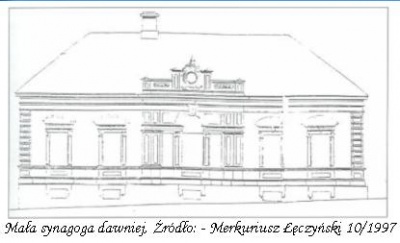
__________________________________________________________
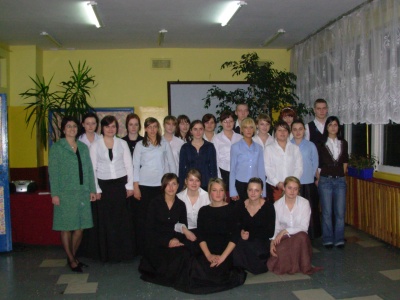
On January 9th we presented to other students and guests a play entitled „To Bring Memory Back”. It took place in our school but in not so common scenery, during one evening with candlelight and meals of Jewish cuisine.
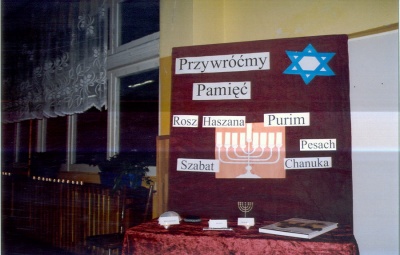
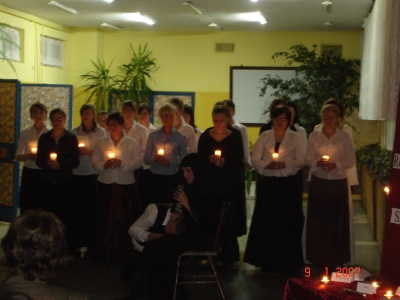
We’ve quoted the information about Jewish culture, focusing on chosen religious feasts: Shabbat, Rosh Hashanah, Passover, Chanukah, and Purim. The show was complemented with dancing and singing the songs like Austeria, Estera’s Lullaby, We’re All Brothers, Ad-lo-yada or Hava Nagila.
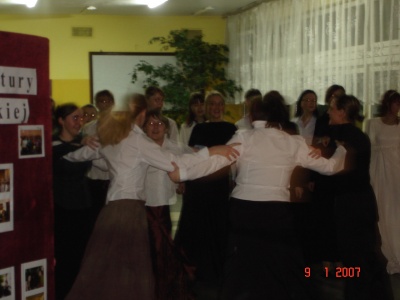
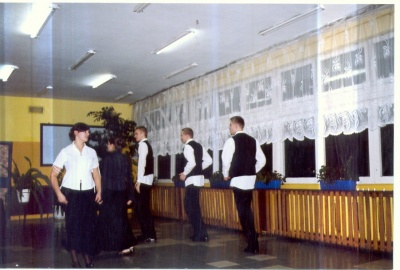
The gathered audience particularly liked the dance of a bride and four young Jews, performed to Justyna Steczkowska’s song “Play, Klezmer Band” (pol. “Graj, klezmerska kapelo”).
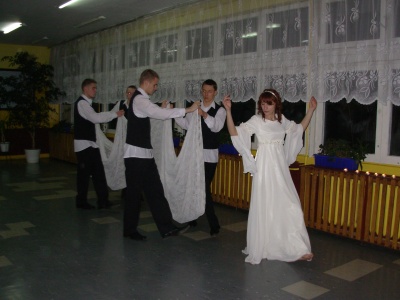
Also the Jewish sayings about roles of men and women in family deserved credit. The performance was awarded with great applause and greetings from the gathered people. After the principal’s speech the guest were invited to some gustation of meals of Jewish cuisine, which we’ve prepared ourselves: cugel, sweet white bread, charoset, potato pan cakes, carrot salad, cymes, herring in apple sauce, stuffed fish, almond cookies and poppy strudel. During the treat some Klezmer music was played.
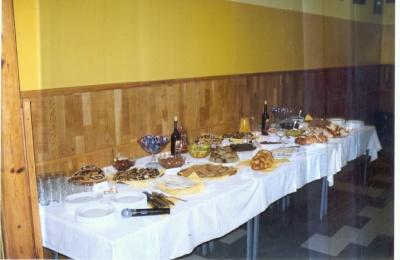
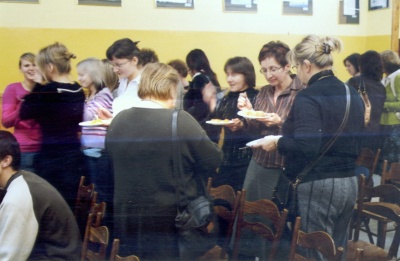
________________________________________________________________________________
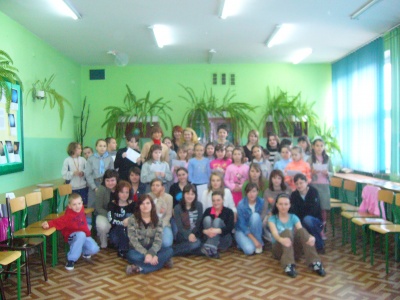
Our circle organized informational workshops for the Second Brownie Scouts Group "Merry Little Dolphins” from Leczna. Children learned about our activities (popularization of Jewish history, culture and symbolism in our region).
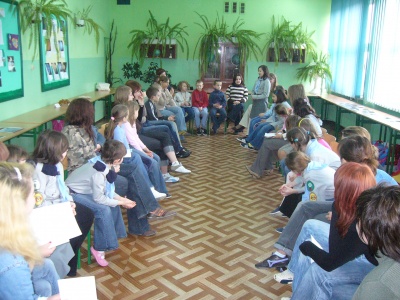
Brownies worked in groups under our supervision and with our help. Very eagerly they did all of the exercises and plays (Gordian knot, playing with chairs, associations). In return they taught us some Scout dancing. Children also learned about some artifacts of Jewish culture – yarmulkes, menorahs, mezuzahs, drawings of the Torah and a synagogue.
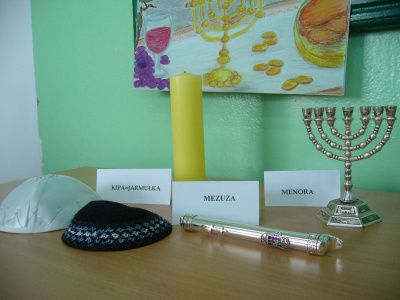
The learning of songs: Hava nagila", "Ad-lo-yada", "Austeria have brought us great joy. The singing was accompanied by a dance of two boys in yarmulkes.
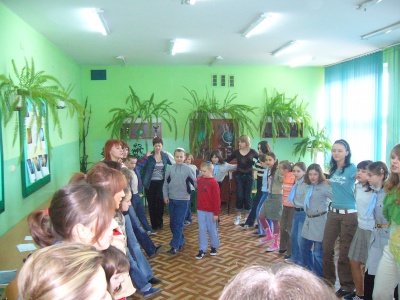
We’ve prepared simple treat for the Brownies: Passover bread, potato pan cakes and nut cookies. The game went on and on.
________________________________________________________________
Educational Session on Holocaust:
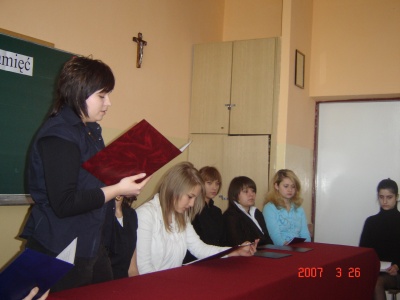
We’ve prepared an educational session on Holocaust. It met with great interest of the students, teachers and principal’s office.
The session was diversified with recorded recollections form the limes of II Word War and Lublin’s ghetto and a documentary movie about Warsaw’s ghetto and relations about situation of Jews of Leczna.We’ve used fragment of a book „Jewish Children Are Accusing” and „We, Polish Jews” by Julian Tuwim which our carer received from Shalom Foundation. The session was ended with a questionnaire investigating students’ knowledge about Holocaust.The survey demonstrated the youth wants the knowledge about crimes of war to pass on to next generations as a lesson for all mankind.
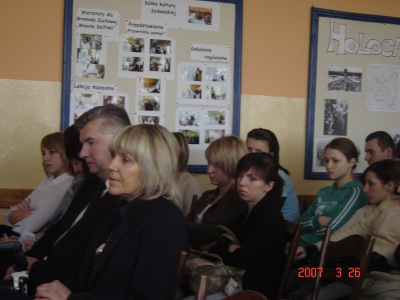
________________________________________________________________
Artistic exhibition:
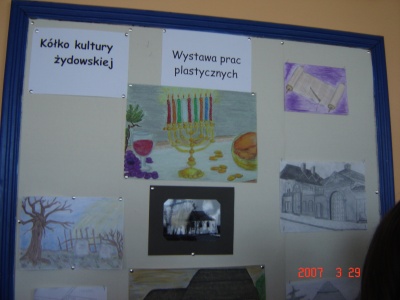
We’ve organized an artistic exhibition of students from the Circle of Jewish Culture and Scout Group „Merry Little Dolphins”. Works made with different techniques show the synagogue in Leczna and elements of Jewish culture as menorah, Torah and yarmulkes which children liked the most.
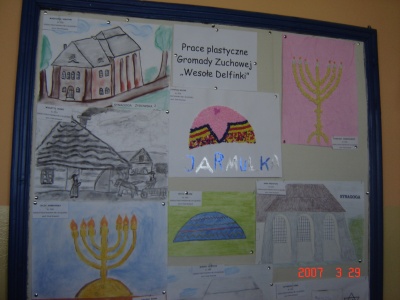
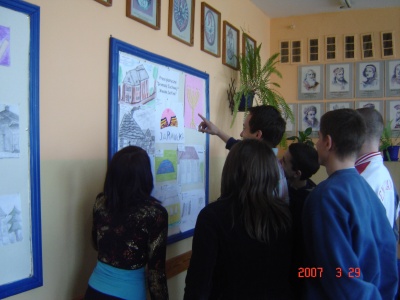
What we are going to do next
We are preparing a school play about Jewish culture, and an interview with those citizens of our town who still remember their Jewish neighbors.
Who is helping us
We are supported by the Regional Museum in Łęczna, and by 2nd Brownie Scouts Troop "Merry Little Dolphins" of Łęczna.
